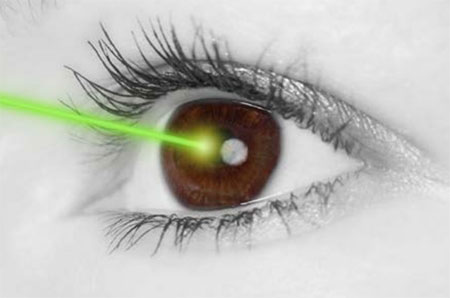WHAT IS LASIK?
LASIK, or Laser-Assisted in situ Keratomileusis, commonly referred to as laser eye surgery or laser vision correction, is a type of refractive surgery for the correction of myopia, hypermetropia, and astigmatism, and recently presbyopia. LASIK surgery is performed by an ophthalmologist who uses a laser or microkeratome to reshape the eye’s cornea in order to improve visual acuity. For most patients, LASIK provides a permanent alternative to eyeglasses or contact lenses.
WHAT IS LASIK EYE SURGERY?
For clear vision, the eye’s cornea and lens must bend (refract) light rays properly, so that images are focused clearly on the retina. Otherwise, the images will be blurry.
This blurriness is referred to as a “refractive error.” It is caused by an incompatible difference between the curve of the cornea and the length of the eye.
LASIK uses an excimer laser (an ultraviolet laser) to precisely remove corneal tissue, giving it a new shape so that light rays are focused clearly on the retina. LASIK causes the cornea to be thinner.
LASIK is an outpatient surgical procedure that takes 10 to 15 minutes for both eyes.

The only anaesthetic used is eye drops that numb the surface of the eye. The procedure is done when you are awake, but you will get medicine to help you relax. LASIK may be done on one or both eyes during the same session.
LASIK involves creating a flap of corneal tissue which is then peeled back so that the excimer laser can reshape the corneal tissue underneath. The amount of tissue the laser will remove is calculated ahead of time. Once the reshaping is done, the surgeon replaces and secures the flap. No stitches are needed. The cornea will naturally hold the flap in place.
Treatment of nearsightedness (myopia),farsightedness and astigmatism
- You should be at least 18 years old because vision may continue to change in people younger than 18. A rare exception is a child with one very nearsighted and one normal eye. Using LASIK to correct a very nearsighted eye may prevent amblyopia (lazy eye).
- You should not have this procedure if you are pregnant or breast-feeding, because these conditions can affect eye measurements.
- You should not have this procedure if you take certain prescription drugs, such as Accutane (Isotretinoin, Isotina, Acnotin, Desactin), miodarone (Cordarone), Sumatriptan (Imitrex), or oral prednisone.
- Your eyes must be healthy and your prescription stable. If you are nearsighted, you should postpone LASIK until your condition has stabilized. Nearsightedness may continue to increase in some patients until their mid to late 20s.
- You should be in good general health. LASIK may not be recommended for patients with diabetes, rheumatoid arthritis, lupus, glaucoma, herpes infections of the eye, or cataracts. You should discuss this with your surgeon.
Other recommendations:
- Weigh the risks and rewards. If you’re happy wearing contacts or glasses, you may not want to have the surgery.
- Make sure you have realistic expectations from the surgery.
TREATMENT OF PRESBYOPIA
No one escapes presbyopia, which begins to show up at about age 40. Solutions for presbyopia include eyeglasses, multifocal contact lenses, artificial lenses, and LASIK eye surgery
There are two LASIK procedures used to correct presbyopia:
- LASIK can be done to allow one eye to see near and the other far, which is called “monovision.” provides monovision. This means one eye is corrected for better distance vision, and the other eye is corrected to enhance near vision. Many people cannot adapt to this kind of sight, which can cause problems such as loss of depth perception.
- Multifocal LASIK: An Excimer laser reshapes your cornea into different zones for near, far and intermediate vision. In each zone, light is bent or refracted differently, allowing people with presbyopia to regain good vision at all distances
WHAT ARE THE POSSIBLE RISKS AND COMPLICATIONS OF THE PROCEDURE
A small percentage of people may need to have another surgery because the condition is over-or under-corrected. Sometimes, you will still need to wear contact lenses or glasses.
Risks may include:
- Corneal infection
- Corneal scarring or permanent problems with the cornea’s shape, making it impossible to wear contact lenses
- Decrease in contrast sensitivity – even with 20/20 vision, objects may appear fuzzy or gray
- Dry eyes
- Glare or haloes
- Light sensitivity
- Night driving problems
- Patches of red or pink in the white of the eye (usually temporary)
- Reduced vision or permanent vision loss
- Scratchiness
HOW SHOULD I PREPARE BEFORE THE PROCEDURE?
A complete eye examination will be done before surgery to make sure your eyes are healthy.
A signed informed consent form is needed before the procedure. This form confirms that you know the procedure’s risks, benefits, alternative options, and possible complications.
WHAT HAPPENS AFTER THE PROCEDURE?
You will be given sunglasses to protect the flap and to help prevent rubbing or pressure on the eye. You will be asked to wear them permanently, even while sleeping, during the first 3 days, then only when going outdoor for the next 3 weeks.
OUTCOME
Most people’s vision will stabilize in a few days after surgery, but for some people it may take up to 3 – 6 months.
Some people need a second surgery to get the best possible results. Although a second surgery may improve distance vision, it may not relieve other symptoms such as glare, haloes, or problems with night driving. Often, these problems will go away by 6 months after the surgery, but a small number of people may continue to have problems with glare.
If your distance vision has been corrected with LASIK, it is likely that you will still need reading glasses at around age 45 to 50.
For further enquires and appointment, please contact the Ophthalmology Department – FV Hospital at (+84.8) 5411 3436 or (+84.8) 5411 3333 – ext: 2000
And in case of Emergency: (+84.8) 5411 3500



